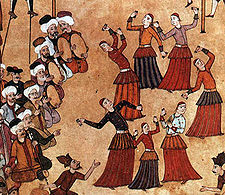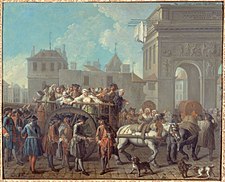Prostitution
| Occupation | |
|---|---|
Activity sectors | Sex industry |
| Description | |
Related jobs | Stripper,porn actor |
Prostitutionis the business or practice of engaging insexual activity in exchange for payment.[1][2]The definition of "sexual activity" varies, and is often defined as an activity requiringphysical contact(e.g.,sexual intercourse,non-penetrative sex,manual sex,oral sex,etc.) with the customer.[3]The requirement of physical contactalso creates the risk of transferring infections.Prostitution is sometimes described assexual services,commercial sexor, colloquially,hooking.It is sometimes referred to euphemistically as "theworld's oldest profession"in theEnglish-speaking world.[4][5]A person who works in the field is usually called aprostituteorsex worker,but other words, such ashooker,putana,orwhore,are sometimes usedpejorativelyto refer to those who work as prostitutes.
Prostitution occurs in a variety of forms, andits legal statusvaries fromcountry to country(sometimes from region to region within a given country), ranging from being an enforced or unenforced crime, to unregulated, to a regulated profession. It is one branch of thesex industry,along with pornography,stripping,anderotic dancing.Brothelsare establishments specifically dedicated to prostitution. Inescort prostitution,the act may take place at the client's residence or hotel room (referred to as out-call), or at the escort's residence or a hotel room rented for the occasion by the escort (in-call). Another form isstreet prostitution.
According to a 2011 report by Fondation Scelles there are about 42 million prostitutes in the world, living all over the world (though most of Central Asia, the Middle East and Africa lack data, studied countries in that large region rank as topsex tourismdestinations).[6]Estimates place the annual revenue generated by prostitution worldwide to be over $100 billion.[7]
The majority of prostitutes are female and have male clients.[8][9]
The position of prostitution and the law varies widely worldwide, reflecting differing opinions. Some view prostitution as a form of exploitation of orviolence against women,[10]andchildren,[11]that helps to create a supply of victims forhuman trafficking.[12][13]Some critics of prostitution as an institution are supporters of the "Nordic model"that decriminalizes the act of selling sex and makes the purchase of sex illegal. This approach has also been adopted byCanada,Iceland,Ireland,[14]Northern Ireland,Norway,FranceandSweden.Others view sex work as a legitimate occupation, whereby a person trades or exchanges sexual acts for money.Amnesty Internationalis one of the notable groups calling for thedecriminalization of prostitution.[15]
Etymology and terminology
General
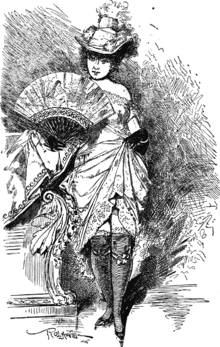
Prostituteis derived from theLatinprostituta.Some sources cite the verb as a composition of "pro"meaning" up front "or" forward "and"stituere",defined as" to offer up for sale ".[16]Another explanation is thatprostitutais a composition ofproandstatuere(to cause to stand, to station, place erect). A literal translation therefore is: "to put up front for sale" or "to place forward". TheOnline Etymology Dictionarystates, "The notion of 'sex for hire' is not inherent in the etymology, which rather suggests one 'exposed to lust' or sex 'indiscriminately offered.'"[17][18]
The wordprostitutewas then carried down through various languages to the present-day Western society. Mostsex worker activistsgroups reject the wordprostituteand since the late 1970s have used the termsex workerinstead. However,sex workercan also mean anyone who works within the sex industry or whose work is of a sexual nature and is not limited solely to prostitutes.[19][20]
A variety of terms are used for those who engage in prostitution, some of which distinguish between different types of prostitution or imply a value judgment about them. This terminology is hotly contested among scholars.[21]Common alternatives forprostituteincludeescortandwhore;however, not all professional escorts are prostitutes.
The English wordwhorederives from theOld Englishwordhōra,from theProto-Germanic*hōrōn(prostitute), which derives from theProto-Indo-Europeanroot*keh₂-meaning "desire", a root which has also given us Latincārus(dear), whence the Frenchcher(dear, expensive) and the Latincāritās(love, charity). Use of the wordwhoreis widely consideredpejorative,especially in its modern slang form ofho.In Germany, however, most prostitutes' organizations deliberately use the wordHure(whore) since they feel thatprostituteis a bureaucratic term.[citation needed]
Those seeking to remove the social stigma associated with prostitution often promote terminology such assex worker,commercial sex worker(CSW) orsex trade worker.Another commonly used word for a prostitute ishooker.Although a popular etymology connects "hooker" withJoseph Hooker,a Union general in theAmerican Civil War,the word more likely comes from the concentration of prostitutes around the shipyards and ferry terminal of theCorlear's Hookarea ofManhattanin the 1820s, who came to be referred to as "hookers".[22]Astreetwalkersolicits customers on the streets or in public places, while acall girlmakes appointments by phone, or in recent years, through email or the internet.
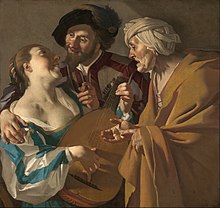
Correctly or not, the use of the wordprostitutewithout specifying a sex may commonly be assumed to be female; compound terms such asmale prostitutionormale escortare therefore often used to identify males. Those offering services to female customers are commonly known asgigolos;those offering services to male customers arehustlersorrent boys.
Procuring
Organizers of prostitution may be known colloquially aspimpsif male ormadamsif female. More formally, one who is said to practice procuring is aprocurer,orprocuress.[23]They may also be calledpanderersorbrothel keepers.
Examples of procuring include:
- deriving financial gain from the prostitution of another
- operating a prostitution business
- traffickinga person into a country for the purpose of soliciting sex
- transporting a prostitute to the location of their arrangement
Clients
Clients of prostitutes, most often men byprevalence,are sometimes known asjohnsortricksin North America andpuntersin Britain and Ireland. These slang terms are used among both prostitutes and law enforcement for persons who solicit prostitutes.[24]The termjohnmay have originated from the frequent customer practice of giving one's name as "John", a common name inEnglish-speakingcountries, in an effort to maintain anonymity. In some places, men who drive aroundred-light districtsfor the purpose of soliciting prostitutes are also known askerb crawlers.
Female clients of prostitutes are sometimes referred to asjanesorsugar mamas.[25][26][27]
Other meanings
The word "prostitution" can also be used metaphorically to mean debasing oneself or working towards an unworthy cause or "selling out".[28]In this sense, "prostituting oneself" or "whoring oneself" the services or acts performed are typically not sexual. For instance, in the bookThe Catcher in the Rye,Holden Caulfieldsays of his brother ( "D.B." ): "Now he's out in Hollywood, D.B., being a prostitute. If there's one thing I hate, it's the movies. Don't even mention them to me." D.B. is not literally a prostitute; Holden feels that his job writingB-moviescreenplays is morally debasing.
The prostitution metaphor, "traditionally used to signify political inconstancy, unreliability, fickleness, a lack of firm values and integrity, and venality, has long been a staple of Russian political rhetoric.[29]One of the famous insults ofLeon Trotskymade byJoseph Stalinwas calling him a "political prostitute".[29]Leon Trotskyused this epithet himself, calling German Social Democracy, at that time "corrupted byKautskianism",a" political prostitution disguised by theories ".[30]In 1938, he used the same description for theComintern,saying that the chief aim of the Bonapartist clique ofStalinduring the preceding several years "has consisted in proving to the imperialist 'democracies' its wise conservatism and love for order. For the sake of the longed alliance with imperialist democracies [Stalin] has brought the Comintern to the last stages of political prostitution."[31]
Besides targeting political figures, the term is used in relation to organizations and even small countries, which "have no choice but to sell themselves", because their voice in world affairs is insignificant. In 2007, a Russian caricature depicted the Baltic states as three "ladies of the night", "vying for the attentions of Uncle Sam, since the Russian client has run out of money".[29]
Usage of the "political prostitute" moniker is by no means unique to the Russian political lexicon, such as when aHuffington Postcontributor expressed the opinion thatDonald Trumpwas "prostituting himself to feed his ego and gain power" when he ran for President of the United States.[32]
Sex work researcher and writer Gail Pheterson writes that these metaphorical usages exist because "the termprostitutegradually took on a Christian moralist tradition, as being synonymous with debasement of oneself or of others for the purpose of ill-gotten gains ".[33]
History
Europe
Ancient
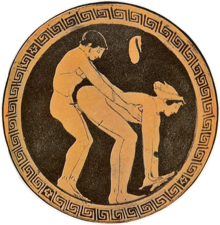
Although historically it was suggested that peoples of theAncient Near Eastengaged insacred prostitutionbased on accounts of ancient Greek authors likeHerodotus,the veracity of these claims has been seriously questioned due to a lack of corroborating evidence.[34][35]Amongst the oldest reliable references toprostitution in ancient Greececomes from theArchaicera poetAnacreon(c. 575 – c. 495 BC) in his poem about Artemon, which references "whores by choice". The record of prostitution in theclassical periodis better documented, and includes references to both free-born voluntary prostitutes, including the high social statushetairai,as well as involuntary slave prostitutes.[36]Male prostitutes also existed in Ancient Greece.[37]
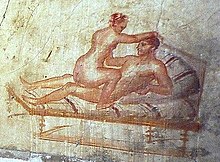
There was never a unified legal approach toprostitution in ancient Rome.[38]In ancient Rome, prostitutes had low social status and were consideredinfamia.[39]Under the reign of emperorCaligula,a taxation on prostitution was implemented.[38]Roman slave owners were able to include thene serva prostituaturcovenantas part of slave sale contracts, which prohibited the slaves being forced to prostitute themselves by their owners after being sold.[40]
Middle Ages
Throughout theMiddle Agesthe definition of a prostitute has been ambiguous, with various secular and canonical organizations defining prostitution in constantly evolving terms. Even though medieval secular authorities created legislation to deal with the phenomenon of prostitution, they rarely attempted to define what a prostitute was because it was deemed unnecessary "to specify exactly who fell into that [specific] category" of a prostitute.[41]The first known definition of prostitution was found in Marseille's thirteenth-century statutes, which included a chapter entitledDe meretricibus( "regarding prostitutes" ).[41]The Marseillais designated prostitutes as "public girls" who, day and night, received two or more men in their house, and as a woman who "did business trading [their bodies], within the confine[s] of abrothel."[42]A fourteenth-century English tract,Fasciculus Morum,states that the termprostitute(termed 'meretrix' in this document), "must be applied only to those women who give themselves to anyone and will refuse none, and that for monetary gain".[42]In general prostitution was not typically a lifetime career choice for women. Women usually alternated their career of prostitution with "petty retailing, and victualing," or only occasionally turned to prostitution in times of great financial need.[43]Women who became prostitutes often did not have the familial ties or means to protect themselves from the lure of prostitution, and it has been recorded on several occasions that mothers would be charged with prostituting their own daughters in exchange for extra money.[44] Medieval civilians accepted without question the fact of prostitution, it was a necessary part of medieval life.[45]Prostitutes subverted the sexual tendencies of male youth, just by existing. With the establishment of prostitution, men were less likely to collectively rape honest women of marriageable and re-marriageable age.[46]This is most clearly demonstrated inSt. Augustine's claim that "the removal of the institution would bring lust into all aspects of the world."[47]Meaning that without prostitutes to subvert male tendencies, men would go after innocent women instead, thus the prostitutes were actually doing society a favor, according to Augustine.
In urban societies there was an erroneous view that prostitution was flourishing more in rural regions rather than in cities, however, it has been proven that prostitution was more rampant in cities and large towns.[48]Although there were wandering prostitutes in rural areas who worked according to the calendar of fairs, similar to riding a circuit, in which prostitutes stopped by various towns based on what event was going on at the time, most prostitutes remained in cities. Cities tended to draw more prostitutes due to the sheer size of the population and the institutionalization of prostitution in urban areas which made it more rampant in metropolitan regions.[48]Furthermore, in both urban and rural areas of society, women who did not live under the rule of male authority were more likely to be suspected of prostitution than their oppressed counterparts because of the fear of women who did not fit into a stereotypical category outside of marriage or religious life.[44]
Secular law, like most other aspects of prostitution in the Middle Ages, is difficult to generalize due to the regional variations in attitudes towards prostitution.[49]The global trend of the thirteenth century was toward the development of positive policy on prostitution as laws exiling prostitutes changed towardssumptuary lawsand the confinement of prostitutes tored light districts.[50]
Sumptuary laws became the regulatory norm for prostitutes and included makingcourtesans"wear a shoulder-knot of a particular color as a badge of their calling" to be able to easily distinguish the prostitute from a respectable woman in society.[50]The color that designated them as prostitutes could vary from different earth tones to yellow, as was usually designated as a color of shame in the Hebrew communities.[51]These laws, however, proved no impediment to wealthier prostitutes because their glamorous appearances were almost indistinguishable from noble women.[52]In the14th century,London prostitutes were only tolerated when they wore yellow hoods.[53]
Although brothels were still present in most cities and urban centers and could range from private bordelages run by a procuress from her home to public baths and centers established by municipal legislation, the only centers for prostitution legally allowed were the institutionalized and publicly funded brothels.[54]This did not prevent illegal brothels from thriving. Brothels theoretically banned thepatronageof married men and clergy, but it was sporadically enforced and there is evidence of clergymen present in brawls that were documented in brothels.[55]Thus the clergy were at least present in brothels at some point or another. Brothels also settled the "obsessive fear of the sharing of women" and solved the issue of "collective security."[56]The lives of prostitutes in brothels were not cloistered like that of nuns and "only some lived permanently in the streets assigned to them."[57]Prostitutes were only allowed to practice their trade in the brothel in which they worked.[58]Brothels were also used to protect prostitutes and their clients through various regulations. For example, the law that "forbid brothel keepers [from] beat[ing] them."[59]However, brothel regulations also hindered prostitutes' lives by forbidding them from having "lovers other than their customers" or from having a favored customer.[59]
Courts showed conflicting views on the role of prostitutes in secular law as prostitutes could not inherit property, defend themselves in court, or make accusations in court.[60]However, prostitutes were sometimes called upon as witnesses during trial.[61]

16th–present
By the end of the 15th-century attitudes seemed to have begun to harden against prostitution. An outbreak ofsyphilisinNaples1494 which later swept across Europe, and which may have originated from theColumbian Exchange,[62]and the prevalence of othersexually transmitted infectionsfrom the earlier 13th century, may have been causes of this change in attitude. By the early 16th century, the association between prostitutes, plague, and contagion emerged, causing brothels and prostitution to be outlawed by secular authority.[63]Furthermore, outlawing brothel-keeping and prostitution was also used to "strengthen the criminal law" system of the sixteenth-century secular rulers.[64] Canon lawdefined a prostitute as "a promiscuous woman, regardless of financial elements."[65]The prostitute was considered a "whore… who [was] available for the lust of many men," and was most closely associated with promiscuity.[66]
The Church's stance on prostitution was three-fold: "acceptance of prostitution as an inevitable social fact, condemnation of those profiting from this commerce, and encouragement for the prostitute torepent."[67]The Church was forced to recognize its inability to remove prostitution from the worldly society, and in the fourteenth century "began to tolerate prostitution as a lesser evil."[68]However, prostitutes were to be excluded from the Church as long as they practiced.[69]Around the twelfth century, the idea of prostitute saints took hold, withMary Magdalenebeing one of the most popular saints of the era. The Church used Mary Magdalene's biblical history of being a reformed harlot to encourage prostitutes to repent and mend their ways.[70]Simultaneously, religious houses were established with the purpose of providing asylum and encouraging the reformation of prostitution. 'Magdalene Homes' were particularly popular and peaked especially in the early fourteenth century.[71]Over the course of the Middle Ages,popesand religious communities made various attempts to remove prostitution or reform prostitutes, with varying success.[72]
With the advent of theProtestant Reformation,numbers of Southern German towns closed their brothels in an attempt to eradicate prostitution.[73]In some periods prostitutes had to distinguish themselves by particular signs, sometimes wearing very short hair or no hair at all, or wearingveilsin societies where other women did not wear them. Ancient codes regulated in this case the crime of a prostitute that dissimulated her profession. In some cultures, prostitutes were the sole women allowed to sing in public or act in theatrical performances.

In the 19th century, legalized prostitution became the center of public controversy as theBritish governmentpassed theContagious Diseases Acts,legislation mandating pelvic examinations for suspected prostitutes; they would remain in force until 1886. TheFrench government,instead of trying to outlaw prostitution, began to view prostitution as a necessary evil for society to function. French politicians chose to regulate prostitution, introducing a "Morals Brigade" onto the streets of Paris.[74]A similar situation did in fact exist in theRussian Empire;prostitutes operating out of government-sanctioned brothels were given yellow internal passports signifying their status and were subjected to weekly physical exams. A major work,Prostitution, Considered in Its Moral, Social, and Sanitary Aspects,was published byWilliam Actonin 1857, which estimated that the County of London had 80,000 prostitutes and that 1 house in 60 was serving as a brothel.[75]Leo Tolstoy's novelResurrectiondescribes legal prostitution in 19th-century Russia.
The leadingMarxist theoristsopposed prostitution. Communist governments often attempted to repress the practice immediately after obtaining power, although it always persisted. In most contemporarycommunist states,prostitution remained illegal but was nonetheless common.[76]The economic decline brought about by thecollapse of the Soviet Unionled to increased prostitution in many current and former Communist countries.[77]
In 1956, the United Kingdom introduced theSexual Offences Act 1956.While this law did not criminalise the act ofprostitution in the United Kingdomitself, it prohibited such activities as running a brothel. Soliciting was made illegal by theStreet Offences Act 1959.These laws were partly repealed, and altered, by theSexual Offences Act 2003and thePolicing and Crime Act 2009.
Since the break up of theSoviet Union,thousands of eastern European women end up as prostitutes in China, Western Europe, Israel, and Turkey every year. Some enter the profession willingly; many are tricked, coerced, or kidnapped, and often experience captivity and violence.[78]There are tens of thousands of women from eastern Europe and Asia working as prostitutes inDubai.Men from Saudi Arabia and the United Arab Emirates form a large proportion of the customers.[79]
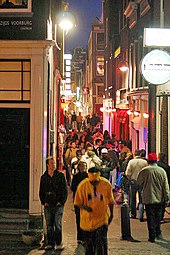
Middle East
In the Islamic world, sex outside of marriage was normally acquired by men not by paying for temporary sex from a free sex worker, but rather by personal sex slave calledconcubine,which was a sex slave trade thatwas still ongoing in the early 20th-century.[80]
Traditionally, prostitution in the Islamic world was historically practiced by way of the pimp temporarily selling his slave to her client, who then returned the ownership of the slave after intercourse. The Islamic Law formally prohibited prostitution. However, since Islamic Law allowed a man to have sexual intercourse with hisslave concubine,prostitution was practiced by a pimp selling his female slave on the slave market to a client, who returned his ownership on the pretext of discontent after having had intercourse with her, which was a legal and accepted method for prostitution in the Islamic world.[81] This form of prostitution was practiced by for exampleIbn Batuta,who acquired several female slaves during his travels.
According toShiaMuslims,Muhammadsanctionedfixed-term marriage—muta'ain Iraq andsighehin Iran—which has instead been used as a legitimizing cover for sex workers, in a culture where prostitution is otherwise forbidden.[82]SunniMuslims, who make up the majority of Muslims worldwide, believe the practice of fixed-term marriage was abrogated and ultimately forbidden by either Muhammad, or one of his successors,Umar.Sunnis regard prostitution as sinful and forbidden. Some writers have argued thatmut'ah[83]andnikah misyar[84]approximate prostitution. Julie Parshall writes thatmut'ahis legalised prostitution which has been sanctioned by theTwelver Shiaauthorities. She quotes the Oxford encyclopedia of modern Islamic world to differentiate between marriage (nikah) andmut'ah,and states that while nikah is for procreation,mut'ahis just for sexual gratification.[85]According to Zeyno Baran, this kind of temporary marriage provides Shi'ite men with a religiously sanctioned equivalent to prostitution.[86]According to Elena Andreeva's observation published in 2007, Russian travellers to Iran considermut'ahto be "legalized profligacy" which is indistinguishable from prostitution.[87]Religious supporters ofmut'ahargue that temporary marriage is different from prostitution for a couple of reasons, including the necessity ofiddahin case the couple have sexual intercourse. It means that if a woman marries a man in this way and has sex, she has to wait for a number of months before marrying again and therefore, a woman cannot marry more than 3 or 4 times in a year.[88][89][90][91][92][93]
According toDervishIsmail Agha, in theDellâkname-i Dilküşâ,theOttomanarchives,[94][95]in thehammams,the masseurs were traditionallyyoung men[broken anchor],who helped wash clients by soaping and scrubbing their bodies. They also worked assex workers.[96]TheOttomantexts describe who they were, their prices, how many times they could bring their customers toorgasm,and the details of their sexual practices.
East Asia
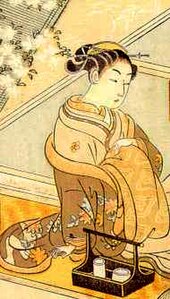
In the early 17th century, there was widespread male and female prostitution throughout the cities ofKyoto,Edo,andOsaka,Japan.Oiranwerecourtesansin Japan during theEdo period.Theoiranwere considered a type ofyūjo(Du nữ)"woman of pleasure" or prostitute. Among theoiran,thetayū(Quá phu)was considered the highest rank of courtesan available only to the wealthiest and highest ranking men. To entertain their clients,oiranpracticed the arts of dance, music, poetry, and calligraphy as well as sexual services, and an educated wit was considered essential for sophisticated conversation. Many became celebrities of their times outside the pleasure districts. Their art and fashions often set trends among wealthy women. The last recordedoiranwas in 1761. Although illegal in modern Japan, the definition of prostitution does not extend to a "private agreement" reached between a woman and a man in abrothel.Yoshiwarahas a large number ofsoaplandswhere women wash men's bodies. They began when explicit prostitution in Japan became illegal, and were originally known astoruko-buro("Turkish bath").
Japanese prostitutes were held in high regard by European travelling men in the 19th century. A British army officer reported that Japanese women were the best prostitutes in the world, for their attractiveness, cleanliness, and intelligence.[97]
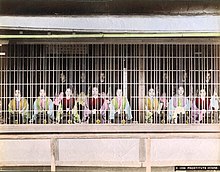
South Asia
TheMahabharataand theMatsya Puranamention fictitious accounts of the origin of Prostitution. Although, Later Vedic texts tacitly, as well as overtly, mention Prostitutes, it is in the Buddhist literature that professional prostitutes are noticed.[98]Atawaifwas acourtesanwho catered to the nobility of theIndian subcontinent,particularly during the era of theMughal Empire.These courtesans danced, sang, recited poetry and entertained their suitors atmehfils.Like thegeishatradition in Japan, their main purpose was to professionally entertain their guests, and while sex was often incidental, it was not assured contractually. High-class or the most popular tawaifs could often pick and choose between the best of their suitors. They contributed to music, dance, theatre, film, and theUrduliterary tradition.[99]
During theEast India Company'srule in Indiafrom 1757 until 1857, it was common for European soldiers serving in thepresidency armiesto solicit the services ofIndian prostitutes,and they frequently paid visits to localnautchdancers for purposes of a sexual nature.[100]Prostitutes from Japan were also popular. Asian prostitutes were held in higher regard than prostitutes from Europe because they came from higher social backgrounds and were regarded as cleaner, more attractive and entertaining than prostitutes back in Europe.[97]
In the 21st century,Afghansrevived a method of prostituting young boys which is referred to as "bacha bazi".[101]
India'sdevadasigirls are forced by their poor families to dedicate themselves to theHindugoddessRenuka.The BBC wrote in 2007 that devadasis are "sanctified prostitutes".[102]
Americas
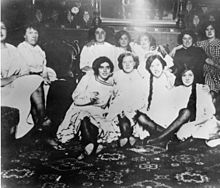

InLatin Americaand theCaribbeansex worker movements date back to the late 19th century in Havana,Cuba.A catalyst in the movement being a newspaper published by Havana sex workers. This publication went by the nameLa Cebolla,created byLas Horizontales.[103]
During this period, prostitution was also very prominent in theBarbary Coast, San Franciscoas the population was mainly men, due to the influx from theGold Rush.[104]One of the more successful madams wasBelle Cora,who inadvertently got involved in a scandal involving her husband, Charles Cora, shooting US Marshal William H. Richardson.[105]This led to the rise of new statutes against prostitution, gambling and other activities seen as "immoral".[104]
Originally, prostitution was widely legal in the United States. Prostitution was made illegal in almost all states between 1910 and 1915 largely due to the influence of theWoman's Christian Temperance Union.[106][107]
On the other hand, prostitution generated much national revenue in South Korea, hence the military government encouragedprostitution for the U.S. military.[108][109]
Beginning in the late 1980s, many states in the US increased the penalties for prostitution in cases where the prostitute is knowingly HIV-positive. Penalties for felony prostitution vary, with maximum sentences of typically 10 to 15 years in prison.
Sex tourismemerged in the late 20th century as a controversial aspect of Western tourism andglobalization.
Historically,and currently, church prostitutes exist, and the practice may be legal or illegal, depending on the country, state or province.[110]
Economics
Prostitutes' salaries and payments fluctuate according to the economic conditions of their respective countries. Prostitutes who usually have foreign clients, such as business travelers, depend on good foreign economic conditions.[111]Payment may vary according to regulations made by pimps, brothel keepers, madams, and procurers, who usually take a slice out of a prostitute's income.[112]Prices may further depend on demand; popular, high-end prostitutes can earn significant amounts of money (upwards of $5,000 per client),[113]and virgins may receive even higher payments.
Laws
This sectionneeds additional citations forverification.(March 2020) |

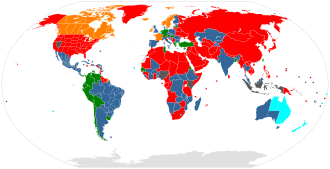
The position of prostitution and the law varies widely worldwide,[114]reflecting differing opinions on victimhood andexploitation,inequality,gender roles,gender equality,ethics andmorality,freedom of choice,historicalsocial norms,andsocial costs and benefits.
Legal themes tend to address four types of issues: victimhood (including potential victimhood), ethics and morality, freedom of choice, and general benefit or harm to society (including harm arising indirectly from matters connected to prostitution).
Prostitution may be considered a form of exploitation (e.g., Sweden, Norway, Iceland, where it is illegal to buy sexual services, but not to sell them—the client commits a crime, but not the prostitute), a legitimate occupation (e.g., Netherlands, Germany, where prostitution is regulated as a profession) or a crime (e.g., manyMuslimcountries, where the prostitutes face severe penalties).
The legal status of prostitution varies from country to country, from being legal and considered aprofessionto beingpunishable by death.[115]Some jurisdictions outlaw the act of prostitution (the exchange of sexual services for money); other countries do not prohibit prostitution itself, but ban the activities typically associated with it (soliciting in a public place, operating a brothel, pimping, etc.), making it difficult to engage in prostitution without breaking any law; and in a few countries prostitution is legal andregulated.
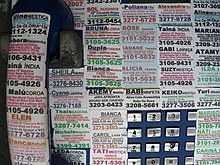
In some countries, there is controversy regarding the laws applicable tosex work.For instance, the legal stance of punishing pimping while keeping sex work legal but "underground" and risky is often denounced as hypocritical; opponents suggest either going the full abolition route and criminalize clients or making sex work a regulated business.
Other groups, often with religious backgrounds, focus on offering women a way out of the world of prostitution while not taking a position on the legal question.
Prostitution is a significant issue in feminist thought and activism. Many feminists are opposed to prostitution, which they see as a form of exploitation of women and male dominance over women, and as a practice that is the result of the existing patriarchal societal order. These feminists argue that prostitution has a very negative effect, both on the prostitutes themselves and on society as a whole, as it reinforces stereotypical views about women, who are seen as sex objects which can be used and abused by men. Other feminists hold that prostitution can be a valid choice for the women who choose to engage in it; in this view, prostitution must be differentiated fromforced prostitution,and feminists should support sex worker activism against abuses by both the sex industry and the legal system.
Decriminalization
Decriminalization views prostitution as labor like any other and that the sex industry premises should not be subject to any special regulation or laws. This is the current situation in New Zealand; the laws against operating a brothel, pimping, and street prostitution are struck down, but prostitution is hardly regulated at all. Proponents of this view often cite instances of government regulation under legalization that they consider intrusive, demeaning, or violent, but feel that criminalization adversely affects sex workers.[116]Amnesty Internationalis one of the notable groups calling for the decriminalization of prostitution.[117][15][118]
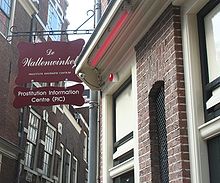
Many countries have sex worker advocacy groups that lobby against criminalization and discrimination of prostitutes. These groups generally oppose Nevada-style regulation and oversight, stating that prostitution should be treated like other professions. In the United States of America, one such group isCOYOTE(an abbreviation for "Call Off Your Old Tired Ethics" ) and another is the North American Task Force on Prostitution.[119]In Australia the lead sex worker rights organisation isScarlet Alliance.[120]Internationalprostitutes' rightsorganizations include theInternational Committee for Prostitutes' Rightsand the Network of Sex Work Projects.[121]
Legalization
Some view prostitution as something to be legalized and regulated: prostitution may be considered a legitimate business; prostitution and the employment of prostitutes are legal, but regulated. This is the current situation in the Netherlands, Germany,[122]most ofAustraliaand parts ofNevada(seeProstitution in Nevada). The degree of regulation varies very much; for example, in the Netherlands, prostitutes are not required to undergo mandatory health checks (seeProstitution in the Netherlands), while inNevada,the regulations are very strict (seeProstitution in Nevada). Because prostitution is considered criminal in many jurisdictions, its substantial revenues are not contributing to the tax revenues of the state, and its workers are not routinely screened for sexually transmitted infections which is dangerous in cultures favouring unprotected sex and leads to significant expenditure in the health services. According to the 1992Estimates of the costs of crime in Australiareport, there was an "estimated $96 million loss of taxation revenue from undeclared earnings of prostitution".[123]
Abolitionism
Inabolitionism,prostitution itself is not prohibited, but most associated activities are illegal, in an attempt to make it more difficult to engage in prostitution, prostitution is heavily discouraged and seen as a social problem. Prostitution (the exchange of sexual services for money) is legal, but the surrounding activities such as publicsolicitation,operating abrotheland other forms ofpimpingare prohibited. This is to some extent the current situation in Great Britain, where prostitution is considered "both a public nuisance and sexual offence", and Italy among others.[124]
Neo-abolitionism
Neo-abolitionismview prostitution as inherently abusive and a form ofviolence against women.[125]Prostitutes are not prosecuted, but their clients and pimps are. In 1999, after lobbying by a coalition of feminists and Christians, Sweden criminalized the buying, not the selling, of sex and neo-abolitionism has come to also be known as the "Nordic model". It has since become law in France, Norway and Iceland (in Norway the law is even more strict, forbidding also having sex with a prostitute abroad).[126]Exxpose, a Dutch group led by evangelical students gathered 40,000 signatures for a petition for the Dutch parliament to adopt the Swedish model but were unsuccessful.[127]Advocates feel that legalizing and regulating prostitution creates a parallel illegal prostitution industry, and fails to dissociate the legal part of the sex trade from crime.[128][129][130][131]
In 1949, theUN General Assemblyadopted aconventionstating that "prostitution and the accompanying evil of the traffic in persons for the purpose of prostitution are incompatible with the dignity and worth of the human person",[132]requiring all signing parties to punish pimps and brothel owners and operators and to abolish all special treatment or registration of prostitutes. As of January 2009, the convention was ratified by 95 member nations including France, Spain, Italy, Denmark, and not ratified by another 97 member nations including Germany, the Netherlands, the United Kingdom, and the United States.
In February 2014, the members of the European Parliament voted in a non-binding resolution, (adopted by 343 votes to 139; with 105 abstentions), in favor of the 'Swedish Model' of criminalizing the buying, but not the selling of sex.[133]
Prohibitionism
Inprohibitionism,both prostitutes and clients are criminalized and are seen as immoral, they are considered criminals. This is the prevailing attitude nearly everywhere in the United States, with a few exceptions in some ruralNevadacounties (seeProstitution in Nevada)
Prostitution, often when it is illegal, is used inextortionandblackmail,which always involves extortion, where the extortionist threatens to reveal information about a victim or their family members that is potentially embarrassing, socially damaging, or incriminating unless a demand for money, property, or services is met. The subject of the extortion may be manipulated into or voluntarily solicit the use of prostitution which is then later used to extort money or for profit otherwise. The filmThe Godfather Part IIfamously depicts the role of Senator Geary who is implicated in the use of prostitution in order to gain his compliance on political issues.[134]
Survival sex
Survival sex is when the prostitute is driven to prostitution by a need for basic necessities such as food or shelter.
Drug addicts
Drug addiction is associated with increased odds of survival sex work.[135]
Homeless
Researchers estimate that ofhomeless youthinNorth America,one in three has engaged in survival sex. In one study of homeless youth inLos Angeles,about one-third of females and half of males said they had engaged in survival sex.[136][137][138]
Refugees
Survival sex is common inrefugee camps.Ininternally displaced personscamps in northernUganda,where 1.4 million civilians have been displaced by conflict between Ugandan government forces and the militantLord's Resistance Army,Human Rights Watchreported in 2005 that displaced women and girls were engaging in survival sex with other camp residents, local defense personnel, and Ugandan government soldiers.[139]
Illegal migrants
A difficulty facing migrant prostitutes in many developed countries is the illegal residence status of some of these women. They face potential deportation, and so do not have recourse to the law. This increases their fear of reporting violence they may suffer, due to their fear of being deported, as well as fear of reprisal from human traffickers.[140][141]The immigration status of the persons who sell sexual services is—particularly in Western Europe—a controversial and highly debated political issue. Currently, in most of these countries, most prostitutes are immigrants, mainly from Eastern and Central Europe; in Spain and Italy 90% of prostitutes are estimated to be migrants, in Austria 78%, in Switzerland 75%, in Greece 73%, in Norway 70% (according to a 2009TAMPEPreport,Sex Work in Europe-A mapping of the prostitution scene in 25 European countries).[142] An article inLe Monde diplomatiquein 1997 stated that 80% of prostitutes inAmsterdamwere foreigners and 70% had no immigration papers.[143]
Caste prostitutes
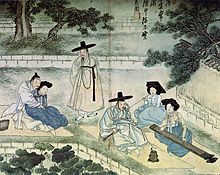
Castes are largely hereditary social classes often emerging around certain professions. Lower castes are associated with professions considered "unclean", which has often included prostitution. In pre-modern Korea, some women from thelower casteCheonmin,known asKisaeng,were trained to provide entertainment, conversation, and sexual services to men of the upper class.[144]In South Asia,castesassociated with prostitution today include theBedias,[145]thePerna caste,[146]theBanchhada,[147]theNat casteand, inNepal,theBadi people.[148][149]
Elderly
Prostitution among the elderly is a phenomenon reported inSouth Koreawhereelderlywomen, calledBacchus Ladies,turn to prostitution out of necessity. They are called that because many also sell the popularBacchusenergy drink to make ends meet.State pensionsof about₩200,000 (US$168) provide a basic income but are often not enough to cover the rising medical bills of old age. It first arose after the1997 Asian financial crisiswhen it became more difficult for children and grandchildren to support their elders. Clients tend to be more senior. The use of erection-inducing injections with reused needles has contributed to the spread of sexually transmitted infections.[150][151]
Forced prostitution
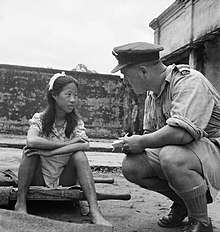
Sex trafficking is defined as using coercion or force to transport an unwilling person into prostitution or other sexual exploitation.[153]The United Nations stated in 2009 thatsex traffickingis the most commonly identified form of human trafficking and estimates that about 79% of human trafficking reported is for prostitution (although the study notes that this may be the result of statistical bias and that sex trafficking tends to receive the most attention and be the most visible).[154]Sex trafficking has been described by Kul Gautum, deputy executive director ofUNICEF,as "the largestslave tradein history. "[155]It is also the fastest growingcriminal industry,predicted to outgrow drug trafficking.[156][157][158]While there may be a higher number of people involved inslaverytoday than at any time in history, the proportion of the population is probably the smallest in history.[159][160]"Annually, according to U.S. Government-sponsored research completed in 2006, approximately 800,000 people are trafficked across national borders, which does not include millions trafficked within their own countries. Approximately 80 percent of transnational victims are women and girls and up to 50 percent are minors", estimated the US Department of State in a 2008 study, in reference to the number of people estimated to be victims of all forms of human trafficking.[161]Due in part to the illegal and underground nature of sex trafficking, the actual extent of women and children forced into prostitution is unknown. A statistical analysis of various measures of trafficking found that the legal status of prostitution did not have a significant impact on trafficking.[13]Globally, forced labour generates an estimated $31 billion, about half of it in the industrialized world and around one-tenth in transitional countries, according to theInternational Labour Organization(ILO) in a report on forced labour ( "A global alliance against forced labour", ILO, 11 May 2005).[162]International trafficking of people has been heavily facilitated by communication technologies.[163]The most common destinations for victims of human trafficking are Thailand, Japan, Israel, Belgium, the Netherlands, Germany, Italy, Turkey, and the US, according to a report by the UNODC (UN Office on Drugs and Crime).[164]Major sources of trafficked persons include Thailand, China, Nigeria, Albania, Bulgaria, Belarus, Moldova, and Ukraine.[164]
The legalization of buying sex is associated with higher human trafficking inflows than countries where it is prohibited. The type of legalization, such as allowing third-party involvement (i.e, “pimps” ), is not shown to make a difference in the effect of sex trafficking inflows.[165]
Use of children
Regarding theprostitution of childrenthe laws on prostitution as well as those on sex with a child apply. If prostitution, in general, is legal there is usually a minimum age requirement for legal prostitution that is higher than the generalage of consent(see above for some examples). In the early 1990s, some countries, mainly in Latin America, did not single out patronage of child prostitution as a separate crime.[166]According to Steinman (2002), by the early 2000s, several such countries had passed laws against child prostitution, yet they were weakly enforced, and pimps continued to profit from the exploitation of minors in Latin America.[167]
Children are sold into the global sex trade every year. Often they are kidnapped or orphaned, and sometimes they are sold by their own families. According to the International Labour Organization, the occurrence is especially common in places such as Thailand, the Philippines, Sri Lanka, Vietnam, Cambodia, Nepal, and India.[168]
In India, the federal police say that around 1.2 million children are believed to be involved in prostitution.[169]ACBIstatement said that studies and surveys sponsored by the ministry of women and child development estimated that about 40% of all India's prostitutes are children.[169]
Children are often medicated to make them appear more mature. In Bangladesh, child prostitutes are known to take the drug Oradexon, also known asdexamethasone.This over-the-countersteroid,usually used by farmers to fatten cattle, makes child prostitutes look larger and older. Charities say that 90% of prostitutes in the country's legalized brothels use the drug. According to social activists, the steroid can causediabetes,high blood pressureand is highly addictive.[170][171][172]In India, some girls are injected withoxytocinto make their breasts grow faster.[173]
Thailand's Health System Research Institute reported that children in prostitution make up 40% of prostitutes in Thailand.[174]
Some adults travel to other countries to have access to sex with children, which is unavailable in their home country. Cambodia has become a notorious destination for sex with children.[175][176]Thailand is also a destination for child sex tourism.[176][177]Several western countries have recently enacted laws with extraterritorial reach, punishing citizens who engage in sex with minors in other countries. As the crime usually goes undiscovered, these laws are rarely enforced.[178][179][180]
Sex care for the disabled
Prostitution is seen by some people with disabilities, or some people with neurological differences – such as some on theautism spectrum– to be an effective way to have sexual experiences, find intimacy, and/or receive human affection that may be difficult for them to come by via traditional means and that may be lacking in their lives.[181][182]A poll byThe Observerin 2008 indicated that 70% of Britons would not consider having sex with someone who has a physical disability.[181]Some people that have disabilities are referred to prostitutes by friends or family, such as a parent or guardian, carers, or support workers.[183]In 2021, a UK judge ruled that council care workers can help disabled people meet prostitutes without breaking the law.[184]Prostitutes that cater to people with disabilities have argued that people with disabilities have the same needs and desires as everyone else.[183]
In some countries such asDenmarkand theNetherlandsaccess to sex workers for those with disabilities is funded by the state on the basis that sexuality is a human right and leads to improved well-being for people with disabilities.[185][186]
Procurement methods
In countries where prostitution is legal, advertising it may be legal (as in theNetherlands) or illegal (as inIndia). Covert advertising for prostitution can take a number of forms:
- by cards in newsagents' windows
- by cards placed in public telephone enclosures: so-calledtart cards
- by euphemistic advertisements in regular magazines and newspapers (for instance, talking of "massages" or "relaxation" )
- in specialistcontact magazines
- via theInternet
In the United States,massage parlorsserving as a cover for prostitution may advertise "full service", a euphemism for coitus.[187]
InLas Vegas,prostitution is often promoted overtly on theLas Vegas Stripby third party workers distributing risque flyers with the pictures and phone numbers of escorts (despite the fact that prostitution is illegal in Las Vegas andClark County,seeProstitution in Nevada).
The way in which prostitutes advertise their presence varies widely. Some remain in apartments that have hints or clues outside such as posters with "model" written on them to lure potential customers inside. Others advertise by putting numbers or locations inphoneboxesor in online or newspaper ads. In more sexually permissive societies, prostitutes can advertise in public view, such as through display windows. In sexually restrictive societies it may occur through word-of-mouth and other means.[188]
Street

In street prostitution, the prostitute solicits customers while waiting at street corners, sometimes called "the track" bypimpsand prostitutes alike. They usually dress in skimpy, provocative clothing, regardless of the weather. In American usage, street prostitutes are often called "streetwalkers" while their customers are referred to as "tricks" or "johns". Servicing the customers is described as "turning tricks". The sex is usually performed in the customer's car, in a nearby alley, or in a rented room. Motels and hotels that accommodate prostitutes commonly rent rooms by half or full hour.
In Russia and other countries of theformer USSR,prostitution takes the form of an open-air market. One prostitute stands by a roadside and directs cars to a so-called "tochka" (usually located in alleyways or carparks), where lines of women are paraded for customers in front of their car headlights. The client selects a prostitute, whom he takes away in his car. Prevalent in the late 1990s, this type of service has been steadily declining in recent years.
A "lot lizard" is a commonly encountered special case of street prostitution.[189]Lot lizards mainly serve those in thetrucking industryattruck stopsand stopping centers. Prostitutes will often propositiontruckersusing aCB radiofrom a vehicle parked in the non-commercial section of a truck stop parking lot, communicating through codes based on commercial driving slang, then join the driver in his truck.
Window prostitution

Window prostitution is a form of prostitution that is fairly common in theNetherlandsand surrounding countries.[190]The prostitute rents a window plus workspace off a window operator for a certain period of time, often per day or part of a day.[191][192][193]The prostitute is also independent and recruits her own customers and also negotiates the price and the services to be provided.[191][192][193]
Brothels

Brothelsare establishments specifically dedicated to prostitution, often confined to specialred-light districtsin big cities. Other names for brothels includebordello,whorehouse,cathouse,knocking shop,andgeneral houses.Prostitution also occurs in somemassageparlours,and in Asian countries in somebarbershops where sexual services may be offered as a secondary function of the premises.
Escorts

Escort services may be distinguished from prostitution or other forms of prostitution in that sexual activities are often not explicitly advertised as necessarily included in these services; rather, payment is often noted as being for an escort's time and companionship only, although there is often an implicit assumption that sexual activities are expected.
In escort prostitution, the act takes place at the customer's residence or hotel room (referred to as out-call), or at the escort's residence, or in a hotel room rented for the occasion by the escort (called in-call). The prostitute may be independent or working under the auspices of anescort agency.Services may be advertised over the Internet, in regional publications, or in local telephone listings.
Use of the Internet by prostitutes and customers is common.[195]A prostitute may use adult boards or create a website of their own with contact details, such as email addresses. Adult contact sites, chats, and online communities are also used. This, in turn, has brought increased scrutiny from law enforcement, public officials, and activist groups toward online prostitution. In 2009,Craigslistcame under fire for its role in facilitating online prostitution, and was sued by some 40 US state attorneys general, local prosecutors, and law enforcement officials.
Reviews of the services of individual prostitutes can often be found at various escort review boards worldwide. Theseonline forumsare used to trade information between potential clients, and also by prostitutes to advertise the various services available. Sex workers, in turn, often use online forums of their own to exchange information on clients, particularly to warn others about dangerous clients.
Sex tourism
Sex tourismis travel forsexual intercoursewith prostitutes or to engage in other sexual activity. TheWorld Tourism Organization,a specialized agency of the United Nations, defines sex tourism as "trips organized from within the tourism sector, or from outside this sector but using its structures and networks, with the primary purpose of effecting a commercial sexual relationship by the tourist with residents at the destination".[196]
As opposed to regular sex tourism, which is often legal, a tourist who has sex with achild prostitutewill usually be committing a crime in the host country, under the laws of his own country (notwithstanding him being outside of it) and againstinternational law.Child sex tourism (CST) is defined as travel to a foreign country for the purpose of engaging in commercially facilitatedchild sexual abuse.[197]Thailand, Cambodia, India, Brazil, and Mexico have been identified as leading hotspots of child sexual exploitation.[198]
Virtual sex
Virtual sex,that is, sexual acts conveyed by messages rather than physically, is also the subject of commercial transactions. Commercialphone sexservices have been available for decades. The advent of the Internet has made other forms of virtual sex available for money, including computer-mediatedcybersex,in which sexual services are provided in text form by way ofchat roomsorinstant messaging,or audiovisually through awebcam(seecamgirl).
Organization
Labor unions
TheInternational Union of Sex Workersis a United Kingdom-basedlabor unionfor sex workers and is affiliated with thegeneral trade union,GMB.
Communities
Daulatdia,sometimes called the world's largest brothel, is an entire village in Bangladesh dedicated to prostitution. Many were born there, being the children of prostitutes.[199]Another similar community in Bangladesh isKandapara.[200]The village ofVadia,India, is known locally as thevillage of prostitutes,where unmarried women are involved in prostitution. Mass weddings for children of prostitutes in the village are held to protect them from being pushed into prostitution.[201]
Prevalence
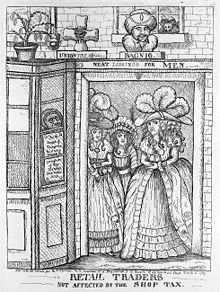
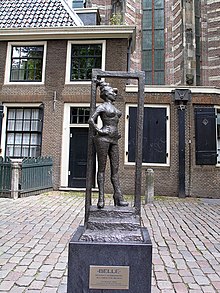
According to the paper "Estimating the prevalence and career longevity of prostitute women",[202]the number of full-time equivalent prostitutes in a typical area in the United States (Colorado Springs, CO, during 1970–1988) is estimated at 23 per 100,000 population (0.023%), of which some 4% were under 18. The length of these prostitutes' working careers was estimated at a mean of 5 years. According to a 2012 report byFondation Scellesthere are between 40 and 42 million prostitutes in the world.[203]
In 2003, it was estimated that inAmsterdam,one woman in 35 was working as a prostitute, compared to one in 300 in London.[204]
The number of men who have used a prostitute at least once varies widely from country to country, from an estimated low of between 7%[205]and 8.8%[206]in theUnited Kingdom,to a high of between 59% and 80% in Cambodia.[207]A study conducted byProCon– a nonpartisan nonprofit organization – estimated the percentage of men who had paid for sex at least once in their lives, and found the highest rates in Cambodia (between 59 and 80% of men had paid for sex at least once) and Thailand (an estimated 75%), followed by Italy (16.7–45%), Spain (27–39%), Japan (37%), the Netherlands (13.5–21.6%), the United States (15.0–20.0%), and China (6.4-20%).[207]Nations with higher rates of prostitution clients display much more positive attitudes towards commercial sex.[207]In some countries, such as Cambodia and Thailand, sex with prostitutes is considered commonplace and men who do not engage in commercial sex may be considered unusual by their peers.[207]In Thailand, it has been reported that about 75% of men have visited a prostitute at least once in their lifetimes. In Cambodia, that figure is 59% to 80%.[207]
In the United States, a 2004 TNS poll reported 15% of all men admitted to having paid for sex at least once in their life.[208]However, a paper entitled "Prostitution and the sex discrepancy in reported number of sexual partners" concluded that men's self-reporting of prostitutes as sexual partners provides a serious underestimate.[209]
In Australia, a survey conducted in the early 2000s showed that 15.6% of men aged 16–59 reported paying for sex at least once in their life, and 1.9% had done so in the past year.[210]
Reports disagree on whether prostitution levels are growing or declining indeveloped countries.Some studies indicate that the percentage of men engaging in commercial sex in the United States has declined significantly in recent decades: in 1964, an estimated 69–80% of men had paid for sex at least once.[207]Some have suggested that prostitution levels have fallen in sexually liberal countries, most likely because of the increased availability of non-commercial, non-marital sex[211]or, for example in Sweden, because of stricter legal penalties.[212]Other reports suggest a growth in prostitution levels, for example in the US,[213]where again, sexual liberalisation is suggested as the cause. As Norma Ramos, executive director of theCoalition Against Trafficking in Womensays "The more the commercialsex industrynormalizes this behavior, the more of this behavior you get ".[214]
Prostitutes have long plied their trades to the military in many cultures. For example, the British naval port ofPortsmouthhad a flourishing local sex industry in the 19th century, and until the early 1990s there were largered-light districtsnear American military bases in the Philippines. The notoriousPatpongentertainment district inBangkok,Thailand, started as anR&Rlocation for US troops serving in theVietnam Warin the early 1970s. Washington D.C. itself hadMurder Baywhich attracted the military of theCivil War.
Violence against prostitutes
Street prostitutes are at higher risk ofviolent crimethan brothel prostitutes and bar prostitutes.[215][216]
In the United States, the homicide rate for female prostitutes was estimated to be 204 per 100,000.[217]There are substantial differences in rates of victimization between street prostitutes and indoor prostitutes who work as escorts, call girls, or in brothels and massage parlors.[218][219]Violence against male prostitutes is less common.[220]
The call to decriminalize selling sex is in part to reduce harm and violence. Under criminalization, prostitutes become more vulnerable to be victims of crimes, even by serial killers, because those committing crimes know that prostitutes would be less likely to report such crimes to the police as they would risk arrest. Additionally, this puts prostitutes at risk of violence by police as police are able to extort prostitutes by threatening arrest. TheACLU,Human Rights WatchandAmnesty Internationalargue that, in addition to decriminalize selling sex as in theNordic model,decriminalizing buying sex makes it more safer for prostitutes.[221][222][223]
Medical situation
In some places, prostitution may be associated with the spread ofsexually transmitted infections(STIs). Lack of condom use among prostitutes and their clients has been cited as a factor in the spread of HIV in Asia: "One of the main reasons for the rapid spread of HIV in Asian countries is the massive transmission among sex workers and clients".[224]As a result, prevention campaigns aimed at increasing condom use by sex workers have been attributed to play a major role in restricting the spread of HIV.[225]
One of the sources for the spread of HIV in Africa is prostitution, with one study finding that encounters with prostitutes produced 84% of new HIV infections in adult males in Accra, Ghana.[226]The spread of HIV from urban settings to rural areas in Africa has been attributed to the mobility of farmers who visit sex workers in cities, for example in Ethiopia.[227] Some studies of prostitution in urban settings in developing countries, such as Kenya, have stated that prostitution acts as a reservoir of STIs within the general population.[228]
Typical responses to the problem are:
- banning prostitution completely
- introducing a system ofregistrationfor prostitutes that mandates health checks and other public health measures
- educating prostitutes and their clients to encourage the use ofbarrier contraceptionand greater interaction with health care
Some think that the first two measures are counter-productive. Banning prostitution tends to drive it underground, making safe sex promotion, treatment, and monitoring more difficult. Registering prostitutes makes the state complicit in prostitution and does not address the health risks of unregistered prostitutes. Both of the last two measures can be viewed asharm reductionpolicies.
In countries and areas where safer sex precautions are either unavailable or not practiced for cultural reasons, prostitution is an active disease vector for all STIs, including HIV/AIDS, but the encouragement ofsafer sexpractices, combined with regular testing for sexually transmitted infections, has been very successful when applied consistently. As an example, Thailand's condom program has been largely responsible for the country's progress against the HIV epidemic.[224]It has been estimated that successful implementation of safe sex practices in India "would drive the [HIV] epidemic to extinction" while similar measures could achieve a 50% reduction in Botswana.[229]In 2009,UN Secretary-GeneralBan Ki-moonurged all countries to remove bans on prostitution and homosexual sex, because "such laws constitute major barriers to reaching key populations with HIV services". In 2012, the Global Commission on HIV and the Law, which was convened by Ban Ki-moon, and which is an independent body, was established at the request of theUNAIDS,and supported by a Secretariat based at theUNDP,[230]reached the same conclusions, also recommending decriminalization ofbrothelsandprocuring.[231][232][233]Nevertheless, the report states that: "The content, analysis, opinions and policy recommendations contained in this publication do not necessarily reflect the views of the United Nations Development Programme."[230]
TheCOVID-19 pandemichashad an impact on sex work.During the COVID-19 pandemic, contact professions (which includes prostitution, amongst others) had been banned (temporarily) in some countries. This has resulted in a local reduction of prostitution.[234]
Psychological issues
De Marneffe (2009) argued that there are psychological issues that prostitutes face from certain experiences and through the duration or repetition. Some go through experiences that may result "in lasting feelings of worthlessness, shame, and self-hatred". De Marneffe further argued that this may affect the prostitute's ability to perform sexual acts for the purpose of building a trusting intimate relationship, which may be important for their partner. The lack of a healthy relationship can lead to higher divorce rates and can influence unhealthy relationship to their children, influencing their future relationships.[235]
See also
- Brothel
- Common prostitute
- Drugs and prostitution
- Empathy and Prostitution
- Fallen woman
- Index of prostitute articles
- International Day of No Prostitution
- International Day to End Violence Against Sex Workers
- International Whores' Day
- Lady in Red
- List of prostitutes and courtesans
- Mann Act(White-Slave Traffic Act)
- Prostitution among animals
- Prostitution statistics by country
- Recreation and Amusement Association
- Red light violations under the SCS
- Revolting Prostitutes
- Sanky-panky
- Street prostitute
- Transactional sex
- Treating (social activity)
- A Vindication of the Rights of Whores
References
Notes
- ^"Prostitution – Definition and More from the Free Merriam-Webster Dictionary".Merriam-Webster.Retrieved19 September2013.
- ^"Prostitution Law & Legal Definition".US Legal.Retrieved19 March2013.
- ^"What counts as prostitution?"(PDF).Archived fromthe original(PDF)on 13 May 2021.Retrieved13 May2021.
- ^Flowers 1998,p. 5.
- ^Forrest Wickman (6 March 2012)."Rush Limbaugh calls Sandra Fluke a" prostitute ": Is prostitution really the world's oldest profession?".Slate.Retrieved4 February2016.
- ^Gus Lubin (17 January 2012)."There Are 42 Million Prostitutes in the World, And Here's Where They Live".Business Insider.Retrieved14 December2015.
- ^"Prostitution Market Value".25 March 2010.Retrieved22 May2010.This Business Insider article is citing this report (https:// fondationscelles.org/pdf/current-assessment-of-the-state-of-prostitution-2013.pdf) by Fondation Scelles which is an anti human trafficking organization
- ^"There Are 42 Million Prostitutes In The World, And Here's Where They Live".Business Insider.Retrieved15 September2022.
- ^"There The prostitution statistics you have to know".6 April 2015.Retrieved15 September2022.
- ^Meghan Murphy (12 December 2013)."Prostitution by Any Other Name Is Still Exploitation".VICE.Retrieved4 February2016.
- ^Malika Saada Saar (29 July 2015)."The myth of child prostitution".CNN.Retrieved4 February2016.
- ^Carol Tan (2 January 2014)."Does legalized prostitution increase human trafficking?".Journalist's Resource.Retrieved4 February2016.
- ^abCho, Seo-Young (2015)."Modeling for Determinants of Human Trafficking: An Empirical Analysis".Social Inclusion.3(1): 2–21.doi:10.17645/si.v3i1.125.Retrieved5 October2018.
- ^(eISB), electronic Irish Statute Book."Amendment of Act of 1993".irishstatutebook.ie.Retrieved14 May2017.
- ^abQ&A: policy to protect the human rights of sex workers.Amnesty International. Retrieved 23 November 2017.
- ^Perkins & Lovejoy 2007,pp. 2–3.
- ^"prostitute".Online Etymology Dictionary.Retrieved26 June2012.
- ^"Perseus Digital Library".Perseus.tufts.edu.Retrieved26 June2012.
- ^"sex worker".Merriam-webster. 13 August 2010.Retrieved26 June2012.
- ^Weitzer, Ronald (2009). "Sociology of Sex Work".Annual Review of Sociology.35:213–234.doi:10.1146/annurev-soc-070308-120025.ISSN0360-0572.S2CID145372267.
- ^Benoit, C.; Jansson, S. M.; Smith, M.; Flagg, J. (2018). "Prostitution stigma and its effect on the working conditions, personal lives, and health of sex workers".Journal of Sex Research.55(4–5): 457–471.doi:10.1080/00224499.2017.1393652.PMID29148837.S2CID4008671.
- ^"AmericanHeritage / History Now".21 May 2006. Archived fromthe originalon 21 May 2006.Retrieved22 December2014.
- ^Horning, A.; Thomas, C.; Marcus; Sriken, J. (2019)."Risky business: Harlem pimps' work decisions and economic returns".Deviant Behavior.41(2): 160–185.doi:10.1080/01639625.2018.1556863.S2CID150273170.
- ^"Adult Industry Terms and Acronyms".Forum.myredbook. Archived fromthe originalon 9 February 2010.Retrieved23 May2010.
- ^Ling, Justin (4 March 2014)."Opposition parties shy away from sex-work debate".Xtra.Retrieved26 August2018.
- ^"7 Things You Learn As A Cop Pretending To Be A Hooker".Cracked.11 October 2015.
- ^Honwana, Alcinda."Changing Patterns of Intimacy among Young People in Africa." African Dynamics in a Multipolar World (2013): 29-47.
- ^"prostitution – Dictionary definition and pronunciation – Yahoo! Education".Education.yahoo. Archived fromthe originalon 23 March 2010.Retrieved23 May2010.
- ^abcRiabova, Tatiana and Riabova, Oleg (2015) "Gayromaidan" in Fedor, Julie; Portnov, Andriy; and Umland, Andraes (eds.)Journal of Soviet and Post-Soviet Politics and Society: Sociographic Essays on the Post-Soviet Infrastructure for Alternative Healing Practices, Volume 1, Issue 1Columbia University Press.p.105Accessed: 14 March 2017
- ^Trotsky, Leon(1921)."Terrorism and Communism: Chapter 7, The Working Class and Its Soviet Policy".Marxists.org.Retrieved14 March2017.
- ^Trotsky, Leon(September 1938)."New War Flows from Versailles Banditry".Marxists.org.Retrieved14 March2017.
- ^Gerdy, Tom (29 February 2016)."Winner or Just Another Political Prostitute?".The Huffington Post.Retrieved14 March2017.
- ^Pheterson, Gail (1993). "The Whore Stigma: Female Dishonor and Male Unworthiness".Social Text(37): 39–64.doi:10.2307/466259.JSTOR466259.
- ^Beard, Mary; Henderson, John (November 1997)."With This Body I Thee Worship: Sacred Prostitution in Antiquity".Gender & History.9(3): 480–503.doi:10.1111/1468-0424.00072.ISSN0953-5233.S2CID145105205.
- ^Budin, Stephanie Lynn (14 January 2008).The Myth of Sacred Prostitution in Antiquity(1 ed.). Cambridge University Press.doi:10.1017/cbo9780511497766.ISBN978-0-521-88090-9.
- ^Kapparis, Konstantinos (23 October 2017),"1. Prostitution in the Archaic Period",Prostitution in the Ancient Greek World,De Gruyter, pp. 15–46,doi:10.1515/9783110557954-001,ISBN978-3-11-055795-4,retrieved14 February2023
- ^Lear, Andrew (15 November 2013), Hubbard, Thomas K. (ed.),"Ancient Pederasty: An Introduction",A Companion to Greek and Roman Sexualities,Chichester, UK: John Wiley & Sons, Ltd, pp. 102–127,doi:10.1002/9781118610657.ch7,ISBN978-1-118-61065-7,retrieved14 February2023
- ^abMcGinn, Thomas A. J. (27 February 2003).Prostitution, Sexuality, and the Law in Ancient Rome(1 ed.).Oxford University Press.doi:10.1093/acprof:oso/9780195161328.001.0001.ISBN978-0-19-516132-8.
- ^Edwards, Catharine (31 December 1998), Hallett, Judith P.; Skinner, Marilyn B. (eds.),"Unspeakable Professions: Public Performance and Prostitution in Ancient Rome",Roman Sexualities,Princeton University Press, pp. 66–96,doi:10.1515/9780691219547-005,ISBN978-0-691-21954-7,retrieved14 February2023
- ^McGinn, Thomas A. J. (27 February 2003),"Ne Serva Prostituatur: Restrictive Covenants in the Sale of Slaves",Prostitution, Sexuality, and the Law in Ancient Rome(1 ed.), Oxford University PressNew York, pp. 288–319,doi:10.1093/acprof:oso/9780195161328.003.0008,ISBN978-0-19-516132-8,retrieved25 April2023
- ^abRollo-Koster, Joelle (2002). "From Prostitutes to Brides of Christ: The Avignonese Repentises in the Late Middle Ages".Journal of Medieval and Early Modern Studies.31(1): 110.doi:10.1215/10829636-32-1-109.S2CID170873311.
- ^abBullough & Brundage 2000,pp. 243–260.
- ^Roberts 1992,p. 65.
- ^abFindlen, Fontaine & Osheim 2003,p. 98.
- ^Otis 1985,p. 16.
- ^Rossiaud 1996,p. 32.
- ^Bullough & Brundage 1994,p. 34.
- ^abRossiaud 1996,p. 3.
- ^Karras 1998,pp. 13–31.
- ^abSanger 1859,p. 97.
- ^Knauer 2002,pp. 95–117.
- ^Knauer 2002,p. 101.
- ^Mortimer, Ian (2012).The Time Traveller's Guide to Medieval England: A Handbook for Visitors to the Fourteenth Century.Random House. p. 102.ISBN9781448103782.
- ^Karras 1998,p. 32;Rossiaud 1996,p. 6.
- ^Rossiaud 1996,p. 41.
- ^Rossiaud 1996,p. 42.
- ^Rossiaud 1996,p. 43.
- ^Geremek 2006,p. 216.
- ^abKarras 1998,p. 106.
- ^Bullough & Brundage 1994,p. 37.
- ^Karras 1998,pp. 13–107.
- ^"Columbus May Have Brought Syphilis to Europe".LiveScience.15 January 2008.
- ^Otis 1985,p. 41.
- ^Otis 1985,p. 44.
- ^London Commissary Court Act Books.London: Department of Manuscripts. 1470–1473.
- ^Bennett 1989,p. 81.
- ^Otis 1985,p. 13.
- ^Rossiaud 1996,p. 160;Otis 1985,p. 12.
- ^Bullough & Brundage 1994,p. 36.
- ^Karras, Ruth (July 1990). "Holy Harlots: Prostitute Saints in Medieval Legend".Journal of the History of Sexuality.1(1): 4.PMID11622758.
- ^Bullough & Brundage 1994,p. 41;Roberts 1992,pp. 73–4.
- ^Bullough & Brundage 1994,pp. 41–42.
- ^"L. Roper: Luther on sex, marriage, and motherhood. The University of Warwick".
- ^Harsin 1985,pp. 3, 25.
- ^Gale 2002,p. 245.
- ^Flowers 1998,p.169.
- ^Wickman, Forrest (5 November 2011).""Socialist Whores": What did Karl Marx think of prostitutes? ".Slate.Retrieved5 November2011.
- ^Hornblower, Margot (24 June 2001). "The Skin Trade".Time Magazine.Retrieved 19 April 2009.
- ^"Why Dubai's Islamic austerity is a sham – sex is for sale in every bar".The Guardian.16 May 2010.
- ^Zilfi, M. (2010). Women and Slavery in the Late Ottoman Empire: The Design of Difference. Storbritannien: Cambridge University Press. p. 217
- ^B. Belli, "Registered female prostitution in the Ottoman Empire (1876-1909)," Ph.D. - Doctoral Program, Middle East Technical University, 2020. p 56
- ^İlkkaracan 2008,p. 36.
- ^Meri, Josef W.; Bacharach, Jere L. (1 January 2006).Medieval Islamic Civilization: L-Z, index.Taylor & Francis.ISBN9780415966924.
- ^Pohl, Florian (1 September 2010).Muslim World: Modern Muslim Societies.Marshall Cavendish. pp. 52–53.ISBN9780761479277.Retrieved5 April2013.
- ^Parshall, Philip L.; Parshall, Julie (1 April 2003).Lifting the Veil: The World of Muslim Women.InterVarsity Press.ISBN9780830856961.
- ^Baran, Zeyno (21 July 2011).Citizen Islam: The Future of Muslim Integration in the West.A&C Black.ISBN9781441112484.
- ^Andreeva, Elena (2007). Russia and Iran in the great game: travelogues and Orientalism. Routledge studies in Middle Eastern history. 8. Psychology Press. pp. 162–163.ISBN0415771536."Most of the travelers describe the Shi'i institution of temporary marriage (sigheh) as 'legalized profligacy' and hardly distinguish between temporary marriage and prostitution."
- ^Temporary Marriage in Islam Part 6: Similarities and Differences of Mut’a and Regular Marriage | A Shi'ite Encyclopedia | Books on Islam and Muslims | Al-Islam.org.Permanent archived link.
- ^"Iddah Of Mutah".ShiaChat.Archived fromthe originalon 19 June 2018.Retrieved17 November2018.
- ^"Marriage" Mut'ah (temporary marriage) - Islamic Laws - The Official Website of the Office of His Eminence Al-Sayyid Ali Al-Husseini Al-Sistani ".sistani.org.
- ^"The Rules in Matrimony and Marriage".Al-Islam.org.3 October 2012.
- ^"How is Mutah different from prostitution (from a non-Muslim point of view)?".islam.stackexchange.
- ^"Marriage".english.bayynat.org.lb.Archived fromthe originalon 23 February 2018.Retrieved17 November2018.
- ^Gazali 2001,p. 106.
- ^Kemal Sılay (1994).Nedim and the poetics of the Ottoman court.Indiana University.ISBN978-1-878318-09-1.
- ^Toledano 2003,p. 242 "[Flaubert, January 1850:] Be informed, furthermore, that all of the bath-boys arebardashes[male homosexuals]. ".
- ^abHyam, R. (2010).Understanding the British Empire.Cambridge University Press. p. 372.ISBN978-1-139-78846-5.Retrieved1 November2023.
The expatriate was in fact more likely to resort to prostituion overseas because the non-European prostitute was a much more attractive proposition than her British counterpart. Asian prostitutes were amusingly playful hostesses. By contrast, British whores were nasty, dirty, and coarse, drawn from deprived backgrounds. In India and Japan prostituion was an honourable estates, and not furtively conducted. Asian prostitutes were likely to be higher up the social scale, educated, and with a proper training for their art. An army officer told Havelock Ellis that he had known perhaps sixty prostites, of whom the Japanese were easily the best (clean, charming, beautiful and taking an intelligent interest)...
- ^Bhattacharji, Sukumari (1987)."Prostitution in Ancient India".Social Scientist.15(2): 32–61.doi:10.2307/3520437.ISSN0970-0293.JSTOR3520437.
- ^"Mapping cultures".The Hindu.Chennai, India. 11 August 2004. Archived fromthe originalon 27 November 2004.Retrieved23 May2010.
- ^Fisher, Michael H. (2007). "Excluding and Including" Natives of India ": Early-19th-Century British-Indian Race Relations in Britain".Comparative Studies of South Asia, Africa and the Middle East.27(2): 303–314 [304–5].doi:10.1215/1089201x-2007-007.S2CID146613125.
- ^"The Dancing Boys of Afghanistan | FRONTLINE".PBS. 20 April 2010.Retrieved4 January2014.
- ^Slaves to the goddess of fertility.BBC News. 8 June 2007
- ^Cabezas, Amalia L. (29 April 2019)."Latin American and Caribbean Sex Workers: Gains and challenges in the movement".Anti-Trafficking Review(12): 37–56.doi:10.14197/atr.201219123.ISSN2287-0113.S2CID159172969.
- ^abSears 2014.
- ^Jensen 2011.
- ^"The Oldest Profession".CSUN University Library.9 March 2018.Retrieved25 June2023.
- ^"What the History of Prostitution Can Teach Us About Human Trafficking".Dressember.3 April 2019.Retrieved25 June2023.
In the United States, prostitution remained federally permissible and was regulated solely by the state until 1910.
- ^Ghosh, Palash (29 April 2013)."South Korea: A Thriving Sex Industry In A Powerful, Wealthy Super-State".International Business Times.Retrieved21 May2013.
- ^Park, Soo-mee (30 October 2008)."Former sex workers in fight for compensation".Joongang Daily.Archived fromthe originalon 30 April 2013.Retrieved21 May2013.
- ^McCormack, Simon (10 September 2011)."Phoenix Goddess Temple Church Is A Brothel: Police (VIDEO)".Huffingtonpost.Retrieved4 January2014.
- ^"Red-light district hit as tourists become tight-fisted".Smh.au. 1 June 2009.Retrieved25 August2015.
- ^Global Perspectives on Gender and Work: Readings and Interpretations, Jacqueline Goodman – 2000 p.373
- ^"The Economics Of High-End Prostitutes".The Economist.More Intelligent Life. 10 April 2008. Archived fromthe originalon 8 October 2015.Retrieved25 August2015.
- ^"Prostitution".Findlaw.Retrieved23 February2021.
- ^"Iran – Facts on Trafficking and Prostitution".Uri.edu. Archived fromthe originalon 8 October 2014.Retrieved23 May2010.
- ^Sex Workers in Europe ManifestoArchived24 February 2021 at theWayback Machine.International Committee on the Rights of Sex Workers in Europe. 2005.
- ^Amnesty International publishes policy and research on protection of sex workers’ rights.Amnesty International. Published 26 May 2016. Retrieved 23 November 2017.
- ^"Sex Workers' Rights are Human Rights".Amnesty International. 14 August 2015.Retrieved23 November2017.
- ^"Prostitution: North American Task Force On Prostitution".Bayswan.org.Retrieved25 August2015.
- ^"Scarlet Alliance, Australian Sex Workers Association is the national peak sex worker organisation in Australia".Scarletalliance.org.au.Retrieved25 August2015.
- ^"Global Network of Sex Work Projects | Promoting Health and Human Rights".Nswp.org.Retrieved25 August2015.
- ^"Legalizing prostitution lowers violence and disease, report says".Reuters.11 December 2018.Retrieved19 March2020.
- ^"Estimates of the Cost of Crime in Australia"(PDF).30 September 2018. Archived fromthe original(PDF)on 15 December 2005.Retrieved15 March2010.
- ^Carline, Anna; Scoular, Jane (3 March 2017), Ward, Eilis; Wylie, Gillian (eds.),"Almost abolitionism: the peculiarities of prostitution policy in England and Wales",Feminism, Prostitution and the State Abingdon,Routledge, pp. 103–120,ISBN978-1-138-94540-1,retrieved19 March2020
- ^Bindel, Julie (11 October 2017)."Why prostitution should never be legalised".The Guardian.ISSN0261-3077.Retrieved19 March2020.
- ^"New Norway law bans buying of sex".BBC News Online.1 January 2009.
- ^"The idea of criminalising prostitutes' clients is spreading".The Economist.15 June 2019.Retrieved2 February2024.
- ^"10 Reasons for Not Legalizing Prostitution by Janice G. Raymond, Coalition Against Trafficking in Women International, March 25, 2003".Rapereliefshelter.bc.ca. Archived fromthe originalon 17 April 2010.Retrieved23 May2010.
- ^"Feminist Coalition Against Prostitution (FCAP) | Myths and Facts about Nevada Legal Prostitution".Fcap.btik. Archived fromthe originalon 9 January 2010.Retrieved23 May2010.
- ^Jean-Michel."The Legalisation of Prostitution: A failed social experiment".Sisyphe.org.Retrieved23 May2010.
- ^"Legalizing Prostitution Will Not Stop the Harm, Making the Harm Visible, Global Sexual Exploitation of Women and Girls, Speaking Out and Providing Services".Uri.edu. Archived fromthe originalon 2 June 2010.Retrieved23 May2010.
- ^"Convention for the Suppression of the Traffic in Persons and of the Exploitation of the Prostitution of Others"..ohchr.org. Archived fromthe originalon 8 May 2012.Retrieved26 June2012.
- ^"Punish the client, not the prostitute".European Parliament.26 February 2014.
- ^Bergan, Ronald (16 August 2011)."GD Spradlin obituary".The Guardian.ISSN0261-3077.Retrieved13 March2024.
- ^Chettiar, Jill; Shannon, Kate; Wood, Evan; Zhang, Ruth; Kerr, Thomas (2010)."Survival sex work involvement among street-involved youth who use drugs in a Canadian setting".Journal of Public Health.32(3): 322–327.doi:10.1093/pubmed/fdp126.PMC2924786.PMID20061578.Retrieved9 April2023.
- ^Flowers, R. Barri (2010).Street kids: the lives of runaway and thrownaway teens.McFarland. pp. 110–112.ISBN978-0-7864-4137-2.
- ^Neinstein, Lawrence S.; Gordon, Catherine; Katzman, Debra; Rosen, David; Woods, Elizabeth R. (2007).Adolescent Health Care: A Practical Guide.Lippincott Williams & Wilkins. p. 974.ISBN978-0-7817-9256-1.
- ^Greene, J.M.; Ennett, S.T.; Ringwalt, C.L. (1999)."Prevalence and correlates of survival sex among runaway and homeless youth".American Journal of Public Health.89(9): 1406–1409.doi:10.2105/AJPH.89.9.1406.PMC1508758.PMID10474560.
- ^Human Rights Watch (2005).The Less They Know, the Better: Abstinence Only HIV/AIDS Programs in Uganda.New York: Human Rights Watch. p. 55.
- ^"Safeguarding the human rights and dignity of undocumented migrant sex workers"(PDF).PICUM.org.Platform for International Cooperation on Undocumented Immigrants.p.11: "When working as sex workers, undocumented migrants are placed in a doubly precarious situation vis-à-vis state authorities, facing additional discrimination and violence due to stigma and prejudice against sex work, and multiple layers of criminalisation due to their residence status and work. For example, the fear and risks that undocumented migrants face when reporting violence to the police can be exacerbated by fear and risks of prosecution, harassment, or intimidation for being a sex worker. It is also important to recognise that undocumented migrant sex workers that are impacted by policing of sex work are predominantly women of colour.1"
- ^Roth, Venla (9 December 2011).Defining Human Trafficking and Identifying Its Victims: A Study on the Impact and Future Challenges of International, European and Finnish Legal Responses to Prostitution-Related Trafficking in Human Beings.Martinus Nijhoff Publishers. p. 7.ISBN978-90-04-20924-4.
- ^"Sex work in Europe"(PDF).Tampep.eu. Archived fromthe original(PDF)on 14 July 2015.Retrieved25 August2015.
- ^"Netherlands – Facts on Trafficking and Prostitution".Uri.edu. Archived fromthe originalon 2 October 2012.Retrieved26 June2012.
- ^Cho, Grace (2008).Haunting the Korean Diaspora: Shame, Secrecy, and the Forgotten War.University of Minnesota Press.p. 103.ISBN978-0816652754.
- ^Rana, U., Sharma, D. & Ghosh, D. Prostitution in northern Central India: an ethnographical study of Bedia community. Int. j. anthropol. ethnol. 4, 2 (2020).[1]
- ^"This Road Leads to Sex Work".Pacific Standard. 12 March 2018.Retrieved2 January2021.
- ^"The Indian village where child sexual exploitation is the norm".The Guardian.14 January 2019.Retrieved2 January2021.
- ^"Nepal's Badi community finds itself in a bottomless pit of despair".Kathmandu Post. 23 January 2020.Retrieved2 January2021.
- ^"Caste System Binds Nepalese Prostitutes".The New York Times.11 April 2004.Retrieved2 January2021.
- ^Lucy Williamson (10 June 2014)."The Korean grandmothers who sell sex".BBC News.Retrieved28 May2019.
- ^Ng, Desmond (January 29, 2017)"Granny prostitutes reflect South Korea's problem of elderly poverty"Archived31 January 2017 at theWayback MachineChannel NewsAsia
- ^"Photos of Comfort Women from DAUGHTERS OF THE DRAGON".williamandrewsbooks.
- ^Nick Davies (20 October 2009)."Prostitution and trafficking – the anatomy of a moral panic".The Guardian.London.Retrieved22 July2012.
- ^"The 2009 UN Report on TIP"(PDF).Retrieved29 November2011.
- ^"Asia's sex trade is 'slavery'".BBC News. 20 February 2003.Retrieved23 May2010.
- ^"Experts encourage action against sex trafficking".Voice of America. 15 May 2009. Archived fromthe originalon 1 May 2011.Retrieved26 June2012.
- ^"Responding to Modern-Day Slavery".20 October 2006. Archived fromthe originalon 30 November 2006.Retrieved25 February2007.
- ^"Human smuggling eclipses drug trade".bbcnews. 20 June 2002.Retrieved30 May2011.
- ^"Slavery is not dead, just less recognizable".Christian Science Monitor.1 September 2004.Retrieved26 June2012.
- ^E. Benjamin Skinner (18 January 2010)."sex trafficking in South Africa: World Cup slavery fear".Time. Archived fromthe originalon 11 January 2010.Retrieved29 August2010.
- ^"Lost Daughters – An Ongoing Tragedy in Nepal"Archived1 July 2014 at theWayback Machine,Women News Network – WNN, 5 December 2008
- ^"A global alliance against forced labour"(PDF).International Labour Office. 2005.Retrieved26 June2012.
- ^"The challenges of countering human trafficking in the digital era"(PDF).europol.europa.eu.Europol.
- ^ab"UN highlights human trafficking".BBC News.26 March 2007.Retrieved22 May2010.
- ^"Does Legalized Prostitution Increase Human Trafficking?".Harvard Law & International Development Society. 12 June 2014.Retrieved30 January2024.
- ^Problems, European Committee on Crime; Affairs, Council of Europe Directorate of Legal (1 January 1993).Sexual Exploitation, Pornography and Prostitution Of, and Trafficking In, Children and Young Adults: Recommendation No. R (91) 11 and Report of the European Committee on Crime Problems.Council of Europe. p. 32.ISBN978-92-871-2035-9.
Some, but not all, of these nations have laws against pandering. They have laws against pimping. But they have no laws against child prostitutionper se.
- ^Steinman, Kathy (1 January 2002)."Sex Tourism and the Child: Latin America's and the United States' Failure to Prosecute Sex Tourists".UC Law SF Journal on Gender and Justice.13(1): 65.ISSN1061-0901.
- ^"End Child Prostitution and Child Pornography and Trafficking of Children for Sexual Purposes".Ecpat Usa.Retrieved22 July2012.
- ^ab"Official: More than 1M child prostitutes in India – CNN".CNN.11 May 2009.Retrieved22 May2010.
- ^"Bangladesh's teenage brothels hold dark steroid secret".reuters. 19 March 2012.Retrieved20 March2012.
- ^Moorhead, Joanna (5 April 2010)."A new danger for sex workers in Bangladesh".London: guardian.Retrieved20 March2012.
- ^"Bangladesh's dark brothel steroid secret".bbcnews. 30 May 2010.Retrieved20 March2012.
- ^"Meet the girls who are born to be prostitutes".Toronto Star. 13 October 2013.Retrieved9 June2024.
- ^"Desk Review: Trafficking in Minors for Commercial Sexual Exploitation; Thailand"(PDF).Archived fromthe original(PDF)on 6 June 2007.Retrieved26 June2012.
- ^Susan Mcclelland."Child-Sex Trade Thriving in Cambodia".The Canadian Encyclopedia.Archivedfrom the original on 26 February 2014.Retrieved23 May2010.
- ^abP.O. Box 9716."Child Sex Tourism Prevention Project".World Vision. Archived fromthe originalon 20 May 2010.Retrieved23 May2010.
{{cite web}}:CS1 maint: numeric names: authors list (link) - ^"Child Sex Tourism in Thailand"(PDF).End Child Prostitution Pornography and Trafficking. Archived fromthe original(PDF)on 31 July 2007.Retrieved26 June2012.
- ^Hewitt, Duncan (22 January 2002)."Teenage prostitution case shocks China".BBC News.Retrieved26 April2007.
- ^Roberts, Alison (1 September 2003)."Portugal abuse hearings halted".BBC News.Retrieved26 April2007.
- ^"UN damns Czech-German child sex".BBC News. 28 October 2003.Retrieved26 April2007.
- ^abVanquaethem, Eelinn (18 July 2017)."What prostitution can do for disabled people".The National Student.Archived fromthe originalon 15 November 2022.Retrieved15 November2022.
- ^Matthews, Sarah (12 July 2018)."Sex workers offer intimacy and connection for disabled clients in the age of the dating app".ABC News.Retrieved15 November2022.
- ^abBrown, Vanessa (15 December 2015)."Life as a sex worker for people with disabilities".news.au.Retrieved15 November2022.
- ^Casciani, Dominic (29 April 2021)."Carers can help vulnerable clients visit sex workers".BBC News.Retrieved15 November2022.
- ^Dickinson, Helen; Smith, Catherine (21 May 2020)."Why it is" reasonable and necessary "for the NDIS to support people's sex lives".The Conversation.Retrieved15 November2022.
- ^Henriques-Gomes, Luke (21 July 2019)."'We are sexual beings': why disability advocates want the NDIS to cover sexual services ".The Guardian.Retrieved15 November2022.
- ^Rathus, Nevid & Fichner-Rathus 2002.
- ^Scambler & Scambler 1997,p. 1920.
- ^"Sex Trafficking at Truck Stops"(PDF).National Human Trafficking Resource Center.Polaris Project.2012.Retrieved12 August2018.
- ^Di Nicola et al. 2009.
- ^ab"Amsterdam Prostitutes: The Facts about Window Prostitution in Amsterdam".Amsterdam Advisor.Retrieved3 December2017.
- ^ab"Prostitution in Amsterdam".Amsterdam Info.Retrieved3 December2017.
- ^ab"Prostitution in the Netherlands".ProstitutieHulpverleningUtrecht.Retrieved3 December2017.
- ^"Die Welt zu Gast bei Freundinnen",Frankfurter Allgemeine Zeitung,8 June 2006.(in German)
- ^Siegel 2007.
- ^"WTO Statement on the Prevention of Organised Sex Tourism".World Tourism Organization. 22 October 1995. Archived fromthe originalon 10 October 2006.Retrieved2 February2016.
- ^"The Facts About Child Sex Tourism".Fact Sheet.US Dept of State, Office to Monitor and Combat Trafficking in Persons. 29 February 2008.
- ^"RIGHTS-MEXICO: 16,000 Victims of Child Sexual Exploitation – IPS".Ipsnews.net. 13 August 2007. Archived fromthe originalon 26 March 2012.Retrieved23 May2010.
- ^Christine Jackman (26 October 2013)."Daughters of the brothel".Sydney Morning Herald.Retrieved5 February2015.
- ^দেয়ালের অন্য পাশের গল্প- কান্দাপাড়া যৌনপল্লীর অদেখা কিছু ছবি[The Story On The Other Side Of The Wall - Some Unseen Pictures Of Kandapara Sex Village].Bangla Hub - এবার পুরো পৃথিবী বাংলায়!(in Bengali). 13 December 2016.Retrieved11 July2020.
- ^"In pictures: Mass wedding in India 'prostitute village'".BBC.12 March 2012.
- ^Potterat et al. 1990.
- ^Gus Lubin (17 January 2012)."There Are 42 Million Prostitutes in the World, And Here's Where They Live".Business Insider.Retrieved4 January2016.
- ^"Window ban for Zurich's prostitutes".swissinfo. 15 May 2003. Archived fromthe originalon 11 September 2012.Retrieved26 June2012.
- ^Månsson, Sven-Axel."Men's practices in prostitution and their implications for social work"(PDF).Archived fromthe original(PDF)on 6 November 2013.Retrieved26 January2013.
- ^Ward, H; C H Mercer; K Wellings; K Fenton; B Erens; A Copas; A M Johnson (2005)."Who pays for sex? An analysis of the increasing prevalence of female commercial sex contacts among men in Britain"(PDF).Sex Transm Infect.81(6): 467–471.doi:10.1136/sti.2005.014985.PMC1745068.PMID16326848.Archived fromthe original(PDF)on 24 January 2011.Retrieved26 January2013.
- ^abcdef"Percentage of Men (by Country) Who Paid for Sex at Least Once: The Johns Chart".ProCon. Archived fromthe originalon 11 February 2020.Retrieved29 March2015.
- ^Gary Langer, with Cheryl Arnedt and Dalia Sussman (21 October 2004)."Primetime Live Poll: American Sex Survey".ABC News.Retrieved28 March2007.
- ^Brewer, Potterat & Garrett 2000,pp. 12385–12388.
- ^Rissel, Chris E.; Richters, Juliet; Grulich, Andrew E.; Visser, Richard O.; Smith, Anthony M.A. (2003). "Sex in Australia: Experiences of commercial sex in a representative sample of adults".Australian and New Zealand Journal of Public Health.27(2): 191–7.doi:10.1111/j.1467-842X.2003.tb00807.x.PMID14696710.S2CID25225114.
- ^Edlund, Lena; Korn, Evelyn (February 2002)."A Theory of Prostitution"(PDF).Journal of Political Economy.110(1): 181–214.doi:10.1086/324390.S2CID15862773.Archived fromthe original(PDF)on 26 May 2006.
- ^Skarhead, Anna."Evaluating the Swedish Ban on the Purchase of Sexual Services: The Anna Skarhed Report".Nordic Prostitution Policy Reform. Archived fromthe originalon 9 July 2010.Retrieved26 January2013.
- ^Bennetts, Leslie."The John Next Door".2011.The Daily Beast.Retrieved26 January2013.
- ^"CATW submission to the OCHR Committee on the Elimination of Discrimination against Women"(PDF).CATW.Retrieved26 January2013.
- ^"Prostitution Crossroads on Santa Rosa Avenue".Justicewomen. 15 April 2003. Archived fromthe originalon 18 February 2006.Retrieved25 August2015.
- ^Carroll 2009,p. 527.
- ^Potterat, Brewer & Muth 2004;Castillo & Jenkins 1994.
- ^Weitzer R (2005). "New Directions in Research on Prostitution".Crime, Law and Social Change.43(4–5): 211–35.CiteSeerX10.1.1.545.4191.doi:10.1007/s10611-005-1735-6.S2CID145443565.
- ^Weitzer 2000.
- ^Dynes 2016,pp. 1054–1058.
- ^"Why Sex Work Should Be Decriminalized".hrw.org. 7 August 2019.
- ^"It's Time to Decriminalize Sex Work".aclu.org. 3 July 2023.
- ^"Amnesty International publishes policy and research on protection of sex workers' rights".amnesty.org. 26 May 2016.
- ^abRojanapithayakorn W (November 2006)."The 100% condom use programme in Asia".Reprod Health Matters.14(28): 41–52.doi:10.1016/S0968-8080(06)28270-3.PMID17101421.
- ^"HIV Prevention and Sex Workers".20 July 2015.Retrieved15 September2009.
- ^Côté AM, Sobela F, Dzokoto A, et al. (April 2004)."Transactional sex is the driving force in the dynamics of HIV in Accra, Ghana".AIDS.18(6): 917–25.doi:10.1097/00002030-200404090-00009.PMID15060439.S2CID22638286.
- ^Shabbir I, Larson CP (October 1995). "Urban to rural routes of HIV infection spread in Ethiopia".J Trop Med Hyg.98(5): 338–42.PMID7563263.
- ^D'Costa LJ, Plummer FA, Bowmer I, et al. (1985)."Prostitutes are a major reservoir of sexually transmitted diseases in Nairobi, Kenya".Sex Transm Dis.12(2): 64–7.doi:10.1097/00007435-198504000-00002.PMID4002094.S2CID22361492.
- ^Nagelkerke NJ, Jha P, de Vlas SJ, et al. (2002)."Modelling HIV/AIDS epidemics in Botswana and India: impact of interventions to prevent transmission".Bull. World Health Organ.80(2): 89–96.PMC2567721.PMID11953786.
- ^ab"Global Commission on HIV and the Law"(PDF).Hivlawcommission.org.Retrieved25 August2015.
- ^Decriminalisation integral to the fight against HIV,Michael Kirby & Michael Wong, Australian Broadcasting Corporation, 13 July 2012
- ^AIDS used as reason to legalize prostitutes,Cheryl Wetzstein,The Washington Times,2 August 2012
- ^Risks, Rights & Health,GLOBAL COMMISSION ON HIV AND THE LAW, UNDP, HIV/AIDS Group, July 2012, page 43 ( "Recommendation" ): "Repeal laws that prohibit consenting adults to buy or sell sex, as well as laws that otherwise prohibit commercial sex, such as laws against" immoral "earnings," living of the earnings "of prostitution and brothel-keeping."
- ^"Impact of COVID-19 on Sex Workers in Europe".Global Network of Sex Work Projects. 6 July 2020.
- ^Peter de Marneffe,Liberalism and Prostitution(2009).
Bibliography
- Beckman, Karen (2003).Vanishing Women: Magic, Film, and Feminism.Duke University Press.ISBN978-0822330745.
- Bennett, Judith M. (1989).Sisters and Workers in the Middle Ages.University of Chicago Press.ISBN9780226042473.
- Brewer, DD; Potterat, JJ; Garrett, SB; et al. (October 2000)."Prostitution and the sex discrepancy in reported number of sexual partners".Proc. Natl. Acad. Sci. U.S.A.97(22): 12385–8.doi:10.1073/pnas.210392097.PMC17351.PMID11027304.
- Bullough, Vern L.; Brundage, James A. (1994).Sexual Practices and the Medieval Church.Prometheus Books.ISBN9780879752682.
- Bullough, Vern L.; Brundage, James A., eds. (2000).Handbook of Medieval Sexuality.Taylor & Francis.ISBN9780815336624.
- Carroll, Janell L. (2009).Sexuality Now: Embracing Diversity.Wadsworth.ISBN9781439041451.
- Castillo DN, Jenkins EL (February 1994). "Industries and occupations at high risk for work-related homicide".J Occup Med.36(2): 125–32.doi:10.1097/00043764-199402000-00006.PMID8176509.
- Di Nicola, Andrea; Cauduro, Andrea; Lombardi, Marco; Ruspini, Paolo, eds. (2009).Prostitution and Human Trafficking: Focus on Clients.Springer-Verlag New York.ISBN978-0-387-73628-0.
- Dynes, Wayne R. (2016).Encyclopedia of Homosexuality.Routledge.ISBN9781317368113.
- Findlen, Paula; Fontaine, Michelle; Osheim, Duane J. (2003).Beyond Florence: The Contours of Medieval and Early Modern Italy.Stanford University Press.ISBN9780804739351.
- Flowers, Ronald B. (1998).The Prostitution of Women and Girls.McFarland.ISBN9780786404902.
- Gale, Steven H. (2002).Sharp Cut: Harold Pinter's Screenplays and the Artistic Process.University Press of Kentucky. p.245.ISBN978-0-8131-2706-4.
- Gazali, Münif Fehim (2001).Book of Shehzade.Dönence.ISBN978-975-7054-17-7.
- Geremek, Bronislaw (2006).The Margins of Society in Late Medieval Paris.Cambridge University Press.ISBN9780521026123.
- Harsin, Jill (1985).Policing Prostitution in Nineteenth-century Paris.Princeton University Press.ISBN9780691054391.
- İlkkaracan, Pınar (2008).Deconstructing Sexuality in the Middle East: Challenges and Discourses.Ashgate Publishing, Ltd.ISBN9780754672357.
- Jensen, Vickie (2011).Women Criminals: An Encyclopedia of People and Issues [2 volumes]: An Encyclopedia of People and Issues.ABC-CLIO.ISBN9780313068263.
- Karras, Ruth Mazo (1998).Common Women: Prostitution and Sexuality in Medieval England.Oxford University Press.ISBN9780195124989.
- Knauer, Elfriede (2002). "Portrait of a Lady? Some Reflections on Images of Prostitutes from the Later Fifteenth Century".Memoirs of the American Academy in Rome.47:95–117.doi:10.2307/4238794.JSTOR4238794.
- Otis, Leah Lydia (1985).Prostitution in Medieval Society: The History of an Urban Institution in Languedoc.Chicago: University of Chicago Press.ISBN978-0-226-64033-4.
- Perkins, Roberta; Lovejoy, Frances (2007).Call Girls: Private Sex Workers in Australia.University of Western Australia Press.ISBN9781920694913.
- Potterat JJ, Brewer DD, Muth SQ, et al. (April 2004)."Mortality in a long-term open cohort of prostitute women".Am. J. Epidemiol.159(8): 778–85.doi:10.1093/aje/kwh110.PMID15051587.
- Potterat, JJ; Woodhouse, DE; Muth, JB; Muth, SQ (1990). "Estimating the prevalence and career longevity of prostitute women".J. Sex Res.27(2): 233–43.doi:10.1080/00224499009551554.
- Rathus, Spencer A.; Nevid, Jeffrey S.; Fichner-Rathus, Lois (2002).Human Sexuality in a World of Diversity.Allyn and Bacon.ISBN9780205335176.
- Roberts, Nickie (1992).Whores in History: Prostitution in Western Society.HarperCollins.ISBN9780586200292.
0586200290.
- Rossiaud, Jacques (1996).Medieval Prostitution.Barnes & Noble.ISBN9780760701195.
- Sanger, William W. (1859).The History of Prostitution: Its Extent, Causes, and Effects Throughout the World.Harper & brothers.
- Scambler, Graham; Scambler, Annette (1997).Rethinking Prostitution: Purchasing Sex in the 1990s.Psychology Press.ISBN9780415102070.
- Sears, Clare (2014).Arresting Dress: Cross-Dressing, Law, and Fascination in Nineteenth-Century San Francisco.Duke University Press.ISBN9780822357544.
- Siegel, Larry (2007).Criminology: The Core.Cengage Learning.ISBN978-0495094777.
- Toledano, Ehud R. (2003).State and Society in Mid-Nineteenth-Century Egypt.Cambridge University Press.ISBN9780521534536.
- Weitzer, Ronald John (2000).Sex for Sale: Prostitution, Pornography, and the Sex Industry.Routledge.ISBN9780415922944.
Further reading
- Bullough, Vernet al. (1977)A Bibliography of Prostitution.New York: Garland
- Campbell, Russell.Marked Women: Prostitutes and Prostitution in the Cinema,2005 University of Wisconsin Press.
- Cunningham, Scott and Manisha Shah (eds). 2016.The Oxford Handbook of the Economics of Prostitution.Oxford University Press.
- Ditmore, Melissa Hope (2006).Encyclopedia of Prostitution and Sex Work.Greenwood Publishing Group.ISBN9780313329685.
- Keire, Mara L.For Business and Pleasure: Red-Light Districts and the Regulation of Vice in the United States, 1890–1933(Johns Hopkins University Press, 2010); 248 pages; History and popular culture of districts in such cities as New Orleans, New York, San Francisco, El Paso, Hartford, Conn., and Macon, Ga.
- Martin Moen, Ole (2012)."Is prostitution harmful?".J Med Ethics.40(2): 73–81.doi:10.1136/medethics-2011-100367.PMID22930676.
- McCall, Andrew (2004).Medieval Underworld (Sutton History Classics).Thrupp, Stroud, Gloucestershire: Sutton Publishing.ISBN978-0-7509-3727-6.
- Michael, R. T., Gagnon, J. H., Laumann, E. O., & Kolata, G.Sex in America,Boston: Little, Brown, 1994.
- Mirbeau, Octave,The love of a venal woman
- Perlongher, Néstor Osvaldo.O negócio do michê, prostituição viril em São Paulo,1st edition 1987, editora brasiliense.
- Philip, Neil (1991)Working Girls: an illustrated history of the oldest profession.London: BloomsburyISBN978-0-7475-1030-7
- Phoenix, J.Making Sense of Prostitution,Basingstoke: Palgrave, 2001.
- Preston, John.Hustling, A Gentlemen's Guide to the Fine Art of Homosexual Prostitution,Badboy Books, 1997.
- Ramseyer, J. Mark (2008).Odd Markets in Japanese History: Law and Economic Growth.Cambridge University Press.ISBN9780521048255.
- The UNConvention for the Suppression of the Traffic in Persons and of the Exploitation of the Prostitution of Others(1949)
- Walkowitz, Judith R. (1980).Prostitution and Victorian Society: Women, Class, and the State.Cambridge: The University Press.ISBN978-0521223348.
- Weitzer R (2006)."Moral Crusade Against Prostitution"(PDF).Society.43(March–April): 33–8.doi:10.1007/bf02687593.ISSN1524-8879.S2CID144600803.Archived fromthe original(PDF)on 9 September 2008.
External links
 The dictionary definition ofprostituteat Wiktionary
The dictionary definition ofprostituteat Wiktionary Media related toProstitutionat Wikimedia Commons
Media related toProstitutionat Wikimedia Commons Quotations related toProstitutionat Wikiquote
Quotations related toProstitutionat Wikiquote- "Prostitution".Merriam-Webster Dictionary.


